
Pic. 3.3. Engine disassembly stand
1. Install the cylinder block on the stand (see fig. 3.3).
2. Thoroughly clean the mating surfaces and threads in the cylinder block bores.
3. Select pistons for cylinders by class, one group by weight and assemble pistons with connecting rods, as indicated in subsection «Connecting rod and piston group».

Pic. 3.31. Installation of piston rings: 1 - oil scraper ring; 2 - lower compression ring; 3 - top compression ring
4. Install the piston rings with a ring clamp (pic. 3.31).
Note. Rings must be installed in such a way that the mark «top» located on the side of the ring that faces up in the installed position.
5. Rotate the rings in the piston grooves so that the compression ring locks are rotated 120°with respect to the oil scraper ring lock.
6. Lubricate the piston with engine oil.
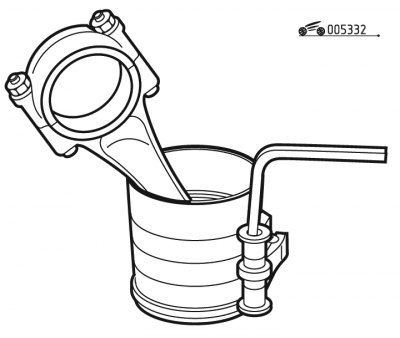
Pic. 3.32. Installation on the piston of the mandrel for installing the piston in the cylinder liner
7. Put a mandrel on the piston assembly with connecting rod to install the piston in the cylinder liner (pic. 3.32).
8. Tighten the mandrel collars with medium force.
9. Install the mandrel with the piston on the sleeve so that the piston can be mounted in the sleeve.

Pic. 3.33. Installing the piston assembly with connecting rod in the cylinder liner
10. Applying force to the connecting rod in the direction of the arrow (pic. 3.33), insert the piston with rings into the cylinder liner so that the piston is completely (with some margin) came out of the cage.
Notes. Liners, if reused, must be installed in the cylinder block in the same places in which they were before disassembly (in accordance with the marks applied during disassembly of the engine). The pistons must be oriented in the cylinder liners so that the marks on the pistons (arrows) were directed towards the drive of the gas distribution mechanism.
11. In the same way, install the remaining pistons complete with connecting rods in the corresponding cylinder liners.

Pic. 3.34. Installing the cylinder liner sealing ring: 1 - cylinder liner sealing ring
12. Install a new O-ring 1 on each sleeve (pic. 3.34), making sure that it is not twisted.
13. Establish loose leaves in rods.
14. Install the assemblies: sleeves, connecting rods, pistons in the cylinder block, observing the installation marks made during disassembly or control of the protrusion of the sleeves.
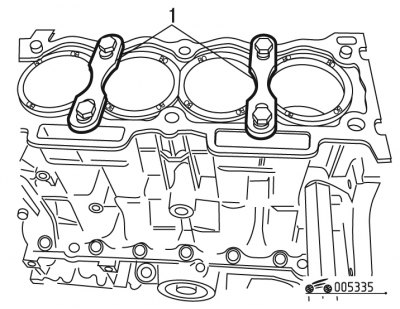
Pic. 3.35. Installation on the cylinder block of clamping plates for holding cylinder liners (tool 0132-A1Z): 1 - set of clamping plates for holding cylinder liners (tool 0132-A1Z)
15. Install kit 1 (pic. 3.35) clamping plates holding the cylinder liners. The plates are mounted on bolts that are screwed into the holes for the block head bolts.

Pic. 3.36. Installation in the bed of the cylinder block of the liners of the main bearings of the crankshaft: 1 - upper shells of the main bearings of the crankshaft
16. Install the liners with a groove in the 2nd and 4th beds of the cylinder block, and in the 1st, 3rd and 5th beds of the cylinder block (and in main bearing caps) - liners without grooves (pic. 3.36).
Notes.
- 1. Pick up loose leaves of radical bearings, as it is specified in subsection «Crankshaft and flywheel».
- 2. Main bearings 1-3-5 of the crankshaft have smooth liners (on the side of the cylinder block and bearing caps).
- 3. Main bearings 2-4 of the crankshaft have liners with grooves (on the side of the cylinder block and bearing caps).
17. Grease loose leaves and necks of a cranked shaft.

Pic. 3.37. Measuring the axial clearance of the crankshaft: 1 - thrust half rings of the crankshaft; 2 - crankshaft; 3 - support rod of the pointer indicator (spare parts catalog number - 0117-AH); 4 - dial indicator support 0118-FZ
18. Lay the crankshaft 2 in the main bearings (pic. 3.37) and insert thrust half rings into the bed of the middle main bearing.
Note. The half rings must face the grooves towards the thrust surfaces of the crankshaft (on the side of the grooves, an anti-friction layer is applied to the surface of the half-ring).
19. Check up an axial backlash of a cranked shaft. To do this, install a rack with a dial indicator on the cylinder block so that the rod 3 (see fig. 3.37) indicator rested against the crankshaft flange. Moving the shaft back and forth (e.g. with screwdrivers), measure the axial clearance with an indicator. It should be in the range of 0.07-0.27 mm. If the gap is greater, then bring it back to normal by replacing the old thrust half rings with new ones or by installing half rings of increased thickness.
20. Lubricate with engine oil and install connecting rod bearings.

Pic. 3.38. Installing the connecting rod caps: 1 - connecting rod covers; A - recess in the connecting rod cap
21. Install the connecting rods and their caps 1 (pic. 3.38) on the crankshaft journals, tighten the connecting rod bolts.
Warnings!
- 1. When assembling the connecting rods, it is necessary to use new connecting rod bolt nuts each time.
- 2. Connecting rod caps must be installed so that the cylinder number on the cap is against the cylinder number on the bottom end of the connecting rod; notches (A) (see fig. 3.38) The connecting rod bearings must fit into the grooves in the connecting rod caps.
22. Tighten the nuts of the connecting rod bolts to 38 Nm.
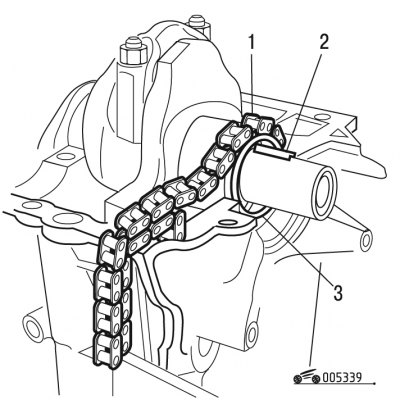
Pic. 3.39. Installing the oil pump drive gear: 1 - oil pump drive chain; 2 - key of the oil pump drive sprocket; 3 - oil pump drive sprocket
23. Insert a segment key 2 into the socket at the front end of the crankshaft (pic. 3.39) and install the oil pump drive sprocket on the shaft.

Pic. 3.40. Installing the housing of the lower covers of the main bearings of the crankshaft: 1 - housing of the lower covers of the main bearings of the crankshaft
24. Install in 2nd and 4th bed of building 1 (pic. 3.40) the lower covers of the main bearings are liners with a groove, and in the 1st, 3rd and 5th beds of the body of the lower covers - liners without a groove.
25. Lubricate the liners with engine oil.
26. Check up presence of aligning pins on the block of cylinders.
27. Check up correctness of selection of pairs of loose leaves of radical bearings.
28. Evenly apply a thin layer of sealant to the plane of the connector (E10).

Pic. 3.41. Tightening of bolts of fastening of the case of the lower covers of main bearings of a cranked shaft: 1 - housing of the lower covers of the main bearings of the crankshaft; 2 - bolts for fastening the lower caps of the main bearings; 3 - bolts for fastening the housing of the lower caps of the main bearings to the cylinder block
29. Install body 1 (pic. 3.41) lower main bearing caps on the cylinder block (from below).

Pic. 3.30. Special tools and fixtures for engine assembly: 1 - clamping plates for holding cylinder liners (used when dismantling engines with an aluminum cylinder block); 2 - pointer indicator support; 3 - support rod of the pointer indicator; 4 - mandrel for installing the crankshaft rear oil seal; 5 - flywheel stopper; 6 - torque wrench with a dial; 7 - a device for fixing the engine flywheel; 8 - mandrel for mounting
30. Tighten the bolts securing the lower caps of the main bearings to a torque of 20 Nm, then tighten by 44°using a torque wrench with a dial (see fig. 3.30) (acting in a spiral, starting with the bolts located in the center).
31. Tighten bolts 3 (see fig. 3.41) fastening the housing of the lower covers of the main bearings to the cylinder block with a force of 8 Nm.

Pic. 3.42. Installing an oil pump with an oil receiver: 1 - oil pump centering pin
32. Check the presence of the centering pin 1 (see fig. 3.42) oil pump.
33. Reinstall the oil pump with oil receiver.
34. Tighten the oil pump mounting bolts to 9 Nm.

Pic. 3.43. Applying sealant to the plane of the cylinder block and oil pan connector
35. Evenly apply a thin layer of sealant to the connector plane (E10) (pic. 3.43).
36. Install the oil pan.
37. Tighten the oil pan mounting bolts to 0.8 Nm.
Warning! Remove any remaining sealant before reinstalling the crankshaft rear oil seal (flywheel side).

Pic. 3.44. Installing the crankshaft rear oil seal: 1 - plug of the oil channel; 2 - rear crankshaft seal; 3 - mandrel for installing the crankshaft rear oil seal
38. Using a mandrel, press a new rear oil seal 2 into the hole in the cylinder block (pic. 3.44) (from the flywheel side of the crankshaft).
39. Reinstall the oil channel plug and tighten it to 30 Nm.
40. Install the flywheel on the engine crankshaft.
41. Apply LOCTITE FRENBLOC to the flywheel mounting bolts prior to installation.

Pic. 3.45. Installing the front crankshaft oil seal: 1 - mandrel for installing the front crankshaft oil seal; 2 - bolt used to install the stuffing box; 3 - front crankshaft oil seal; 4 - flywheel stopper
42. Install stopper 4 in the hole in the cylinder block (pic. 3.45) flywheel.
43. Tighten the flywheel mounting bolts to 67 N.m.
44. Using a mandrel, press a new oil seal into the hole in the cylinder block (from the drive side of the gas distribution mechanism). The final fitting of the oil seal is carried out using bolt 2, which is screwed into the hole in the end of the crankshaft.

Pic. 3.46. Installing the crankshaft sprocket: 1 - a bolt of fastening of a toothed pulley; 2 - remote washer; 3 - key; 4 - toothed pulley of the crankshaft
45. Make sure you have key 3 (pic. 3.46) in a socket at the front end of the crankshaft.
46. Apply a thin layer of sealant evenly (E15) between the crankshaft spacer and the key.
47. Install the crankshaft sprocket spacer.
48. Reinstall the crankshaft sprocket.
49. Reinstall the toothed pulley bolt with washer.
50. Tighten the toothed pulley mounting bolt to 100 Nm.
Note. Make sure there are no traces of sealant (sealing paste) on the crankshaft sprocket.
51. Remove stopper 4 (see fig. 3.45) flywheel.

Pic. 3.47. Coolant pump installation: 1 - cooling system pump
52. Install new pump 1 (pic. 3.47) cooling systems with new gasket (the use of a used gasket is not allowed).
53. Tighten the cooling pump mounting bolts to 18 Nm.
Note. For correct installation of the pump 1 (pic. 3.48) two guide pins are pressed into its body, which must enter the corresponding holes in the cylinder block.

Pic. 3.48. Installing the cooling system pump on engines with an aluminum alloy cylinder block: 1 - pump of the cooling system; 2 - sealing ring; 3 - centering pins of the cooling system pump
54. Make sure there is an O-ring 2 (see fig. 3.48) and dowel pins 3 coolant pumps.
55. Establish the pump 1 of system of cooling in gathering.
56. Tighten the cooling pump mounting bolts to the following torques:
- bolts M10 - 65 Nm;
- bolts M8 - 30 Nm.

Pic. 3.49. Installation of bushings for centering the head on the cylinder block: 1 - bushings for centering the head on the cylinder block; 2 - a device for fixing the engine flywheel
57. Turn the crankshaft so that it can be fixed with tool 2 (pic. 3.49) for fixing the engine flywheel (spare parts catalog number - 0132-QZ).
58. Reinstall bushings 1 to center the cylinder head.
59. Turn the crankshaft so that the pistons of the first and fourth cylinders are at top dead center.

Pic. 3.24. Removing the clamping plates holding the cylinder liners (tool 0132-A1Z): 1 - set of clamping plates for holding cylinder liners (tool 0132-A1Z); 2 - cylinder liners
60. Remove the clamping plates (see fig. 3.24), holding the cylinder liners.
61. Clean the threads of the cylinder head bolt holes with an M10x150 tap.
Note. When assembling the engine, always install a new gasket under the cylinder head. The use of a used gasket is not permitted. Before installing the gasket, it is necessary to remove oil from the mating surfaces of the block and cylinder head. The gasket must be clean and dry. Oil contact with the gasket surface is not allowed.

Pic. 3.50. Bushings for centering the head on the cylinder block: 1 - centering sleeves of the head on the cylinder block
62. Install on the centering sleeves 1 (pic. 3.50) cylinder head (the name of the gasket manufacturer must be at the top).
63. Install the cylinder head bolts pre-lubricated with engine oil.
Note. Before assembling the engine, pre-lubricate the threads and bolt heads by dipping them in engine oil. Then let the excess drain off, holding the bolts for at least 30 minutes.

Pic. 3.51. The order of tightening the cylinder head bolts
64. Tighten the cylinder head bolts in sequence (pic. 3.51).
65. Adjust the clearances in the valve drive mechanism.

Pic. 3.52. Installing the camshaft timing belt covers: 1 - covers of a gear belt of a drive of a camshaft; 2 - bolts of fastening of covers of a gear belt of a drive of a camshaft
66. Install covers 1 (pic. 3.52) camshaft timing belt.
67. Tighten the cap bolts to 8 Nm.
Warning! The exhaust manifold gasket is made of stainless steel. The holes in the exhaust manifold gasket for the outlet of exhaust gases are framed A (pic. 3.53), when installing the gasket, its convex side (in the area of holes) must face the exhaust manifold (from holes in the cylinder block).

Pic. 3.53. Installing the exhaust manifold: 1 - a long nut for fastening the exhaust manifold; 2 - a short nut for fastening the exhaust manifold; 3 - exhaust manifold gasket; 4 - exhaust manifold
68. Install gasket 3 on the studs (see fig. 3.53) exhaust manifold.
69. Install the exhaust manifold on the studs.
70. Tighten nuts 1 and 2 fastening the exhaust manifold.
Warning. There are two types of exhaust manifold nuts: short and long.
Tighten the short nut 2 to 25 Nm, tighten the long nut 1 to 16 Nm.
71. Make sure that the fuel rail elements are correctly positioned and that the injector o-rings are not damaged.

Pic. 3.54. Intake manifold installation: 1 - fuel rail with injectors; 2 - intake manifold
72. Install fuel rail 1 (pic. 3.54).
73. Tighten the bolts of its fastening to a torque of 7 Nm.
74. Install new rubber gaskets on the intake manifold.
75. Install intake manifold 2.
76. Tighten the intake manifold mounting bolts to 8 Nm.
77. Check that the fuel rail connector and manifold are in the correct position.
78. Tighten the mounting bolts to 8 Nm.

Pic. 3.55. Installing the coolant temperature sensor: 1 - coolant temperature sensor; 2 - thermostat block of the cooling system
79. Install sensor 1 (pic. 3.55) coolant temperature.
80. Tighten the sensor to 25 Nm.
81. Apply a thin layer of silicone sealant to the B flange (E10).
82. Install a new thermostatic element in block 2 of the thermostat of the cooling system. Make sure the seal is in place.
83. Apply a thin layer of silicone sealant to the sealing surfaces of both blocks (E10).
84. Establish the block 2 of the thermostat of the cooling system in gathering on a head of the block of cylinders.
85. Tighten the cooling system thermostat block bolts to 8 Nm.

Pic. 3.56. Outlet options with built-in thermostatic element: 1 - G-shaped outlet with built-in thermostatic element (depending on engine type); 2 - thermostatic element; 3 - straight outlet with built-in thermostatic element (depending on engine type); 4 - thermostat block of the cooling system; 5 - fitting

Pic. 3.57. Outlet pipe of the thermostat block with a fitting for draining the coolant to the heat exchanger (depending on vehicle configuration): 1 - fitting; 2 - thermostatic element; 3 - thermostat block
Note. Depending on the engine model, different outlet pipes with a built-in thermostatic element can be installed in the thermostat block (pic. 3.56, 3.57). When installing the nozzle, make sure that the sealing gasket is present.

Pic. 3.58. Installation of hinged elements located on the side of the intake manifold: 1 - eyes for slinging the power unit; 2 - block of compact ignition coils (depending on engine type); 3 - coil casing and ignition coil (depending on engine type); 4 - knock sensor
86. Install eyelets 1 (pic. 3.58) for slinging the power unit.
87. Tighten the sling eye bolts to 30 Nm.
88. Install the spark plugs in the holes in the cylinder head.
89. Tighten the spark plugs to 28 Nm.
90. Install the ignition coil unit.
91. Tighten the ignition coil block bolts to 8 Nm.
92. Install the coil cover and ignition coil.
93. Tighten the ignition coil mounting bolts to 5 Nm.
94. Install knock sensor 4 on the cylinder block.
95. Tighten the knock sensor mounting bolt to 2 Nm.
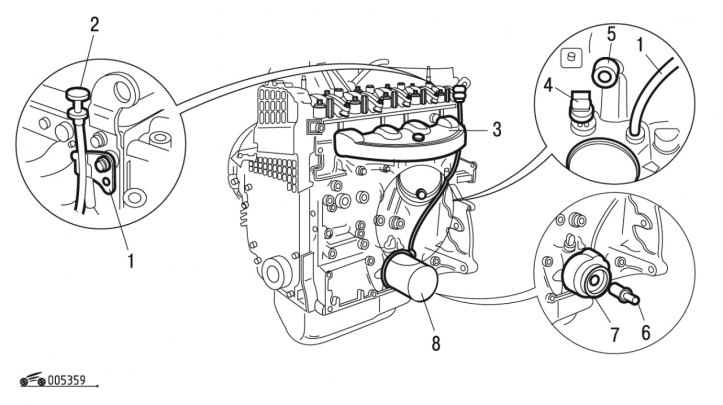
Pic. 3.59. Installation of hinged elements located on the side of the exhaust manifold: 1 - guide tube of the oil dipstick; 2 - oil dipstick; 3 - heat shield of the exhaust manifold; 4 - oil pressure indicator sensor (depending on vehicle configuration); 5 - oil pressure indicator sensor; 6 - threaded fitting (depending on configuration); 7 - heat exchanger (depending on configuration); 8 - oil filter
96. Install heat shield 3 (pic. 3.59) exhaust manifold.
97. Tighten the heat shield mounting bolts to 8 Nm.
98. Install guide tube 1 oil dipstick (the tightness of the connection with the cylinder block is ensured by the use of RECTIJOINT sealant paste).
99. Insert the dipstick into the guide tube.
100. Install the oil pressure gauge sensor.
101. Tighten the sensor to 27 Nm.
102. Install heat exchanger 7 (if it is used on this vehicle) and screw the threaded fitting 6 into it. Tighten the threaded fitting with a torque of 8 Nm.
103. Lubricate the sealing ring of the new oil filter 8 with engine oil and install the filter by screwing it by hand to the fitting on the cylinder block.
104. Establish the gauge 5 of the index of pressure of oil.
105. Tighten sensor 5 to 25 Nm.
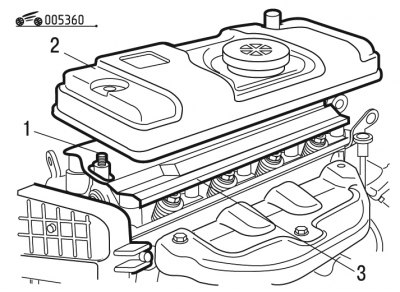
Pic. 3.60. Installing the cylinder head cover: 1 - remote bushings; 2 - cylinder head cover with gasket; 3 - oil deflector screen
106. Install oil deflector 3 (pic. 3.60).
107. Install the two spacers on the studs over the oil screen.
108. Establish on a head of the block of cylinders a cover with a new lining.
Note. The cylinder head cover is available with mounting holes with a diameter of 6 or 8 mm.
109. For cylinder head cover with 8 mm holes: install new sealing washers under the nuts. Tighten the nuts to a torque of 16 Nm.
110. For cylinder head cover with 6 mm holes: tighten the nuts to 7 Nm. Nuts have their own seals, so sealing washers are not placed under them.
Remember that the tightness of the cylinder head cover depends on the thoroughness of all installation operations.
111. Turn the crankshaft until the alignment marks are aligned. You can turn the crankshaft with a key for a bolt temporarily wrapped in the front end of the crankshaft.
The prevention It is forbidden to turn cranked and camshafts at the established head of the block of cylinders if the piston of any of cylinders is in the top dead center. This will cause the piston to hit the valves and damage the valve and crank mechanisms.
112. Install the tension roller and secure it in the position of the minimum belt tension.
113. Put a toothed belt on the crankshaft pulley and, pulling both branches of the belt, put the left branch on the coolant pump pulley and put it behind the tension roller. Put the belt on the camshaft pulley and lightly tighten it with the tension roller, turning the roller axis counterclockwise. When installing the belt, avoid sharp bends.
114. Rotate the crankshaft two turns in the direction of rotation and check that the alignment marks match. If the marks match, adjust the belt tension as described in subsection «Timing gear drive». If the marks do not match, then loosen the belt tension, remove it from the camshaft pulley, turn the pulley to the required angle, put on the belt, slightly tighten it with the tension roller, turn the crankshaft two turns again and check that the alignment marks match.
115. Adjust the valve clearances.
116. Assemble the power unit, as indicated in subsection «Dismantling and assembly of the power unit».
